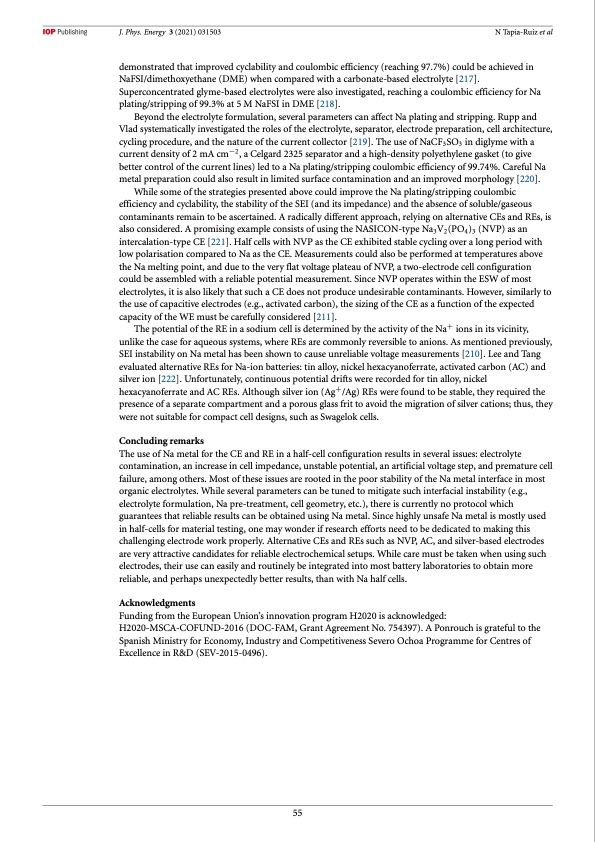
PDF Publication Title:
Text from PDF Page: 056
J. Phys. Energy 3 (2021) 031503 N Tapia-Ruiz et al demonstrated that improved cyclability and coulombic efficiency (reaching 97.7%) could be achieved in NaFSI/dimethoxyethane (DME) when compared with a carbonate-based electrolyte [217]. Superconcentrated glyme-based electrolytes were also investigated, reaching a coulombic efficiency for Na plating/stripping of 99.3% at 5 M NaFSI in DME [218]. Beyond the electrolyte formulation, several parameters can affect Na plating and stripping. Rupp and Vlad systematically investigated the roles of the electrolyte, separator, electrode preparation, cell architecture, cycling procedure, and the nature of the current collector [219]. The use of NaCF3SO3 in diglyme with a current density of 2 mA cm−2, a Celgard 2325 separator and a high-density polyethylene gasket (to give better control of the current lines) led to a Na plating/stripping coulombic efficiency of 99.74%. Careful Na metal preparation could also result in limited surface contamination and an improved morphology [220]. While some of the strategies presented above could improve the Na plating/stripping coulombic efficiency and cyclability, the stability of the SEI (and its impedance) and the absence of soluble/gaseous contaminants remain to be ascertained. A radically different approach, relying on alternative CEs and REs, is also considered. A promising example consists of using the NASICON-type Na3V2(PO4)3 (NVP) as an intercalation-type CE [221]. Half cells with NVP as the CE exhibited stable cycling over a long period with low polarisation compared to Na as the CE. Measurements could also be performed at temperatures above the Na melting point, and due to the very flat voltage plateau of NVP, a two-electrode cell configuration could be assembled with a reliable potential measurement. Since NVP operates within the ESW of most electrolytes, it is also likely that such a CE does not produce undesirable contaminants. However, similarly to the use of capacitive electrodes (e.g., activated carbon), the sizing of the CE as a function of the expected capacity of the WE must be carefully considered [211]. The potential of the RE in a sodium cell is determined by the activity of the Na+ ions in its vicinity, unlike the case for aqueous systems, where REs are commonly reversible to anions. As mentioned previously, SEI instability on Na metal has been shown to cause unreliable voltage measurements [210]. Lee and Tang evaluated alternative REs for Na-ion batteries: tin alloy, nickel hexacyanoferrate, activated carbon (AC) and silver ion [222]. Unfortunately, continuous potential drifts were recorded for tin alloy, nickel hexacyanoferrate and AC REs. Although silver ion (Ag+/Ag) REs were found to be stable, they required the presence of a separate compartment and a porous glass frit to avoid the migration of silver cations; thus, they were not suitable for compact cell designs, such as Swagelok cells. Concluding remarks The use of Na metal for the CE and RE in a half-cell configuration results in several issues: electrolyte contamination, an increase in cell impedance, unstable potential, an artificial voltage step, and premature cell failure, among others. Most of these issues are rooted in the poor stability of the Na metal interface in most organic electrolytes. While several parameters can be tuned to mitigate such interfacial instability (e.g., electrolyte formulation, Na pre-treatment, cell geometry, etc.), there is currently no protocol which guarantees that reliable results can be obtained using Na metal. Since highly unsafe Na metal is mostly used in half-cells for material testing, one may wonder if research efforts need to be dedicated to making this challenging electrode work properly. Alternative CEs and REs such as NVP, AC, and silver-based electrodes are very attractive candidates for reliable electrochemical setups. While care must be taken when using such electrodes, their use can easily and routinely be integrated into most battery laboratories to obtain more reliable, and perhaps unexpectedly better results, than with Na half cells. Acknowledgments Funding from the European Union’s innovation program H2020 is acknowledged: H2020-MSCA-COFUND-2016 (DOC-FAM, Grant Agreement No. 754397). A Ponrouch is grateful to the Spanish Ministry for Economy, Industry and Competitiveness Severo Ochoa Programme for Centres of Excellence in R&D (SEV-2015-0496). 55PDF Image | 2021 roadmap for sodium-ion batteries

PDF Search Title:
2021 roadmap for sodium-ion batteriesOriginal File Name Searched:
roadmap-sodium-ion-batteries_031503.pdfDIY PDF Search: Google It | Yahoo | Bing
Salgenx Redox Flow Battery Technology: Salt water flow battery technology with low cost and great energy density that can be used for power storage and thermal storage. Let us de-risk your production using our license. Our aqueous flow battery is less cost than Tesla Megapack and available faster. Redox flow battery. No membrane needed like with Vanadium, or Bromine. Salgenx flow battery
| CONTACT TEL: 608-238-6001 Email: greg@salgenx.com | RSS | AMP |